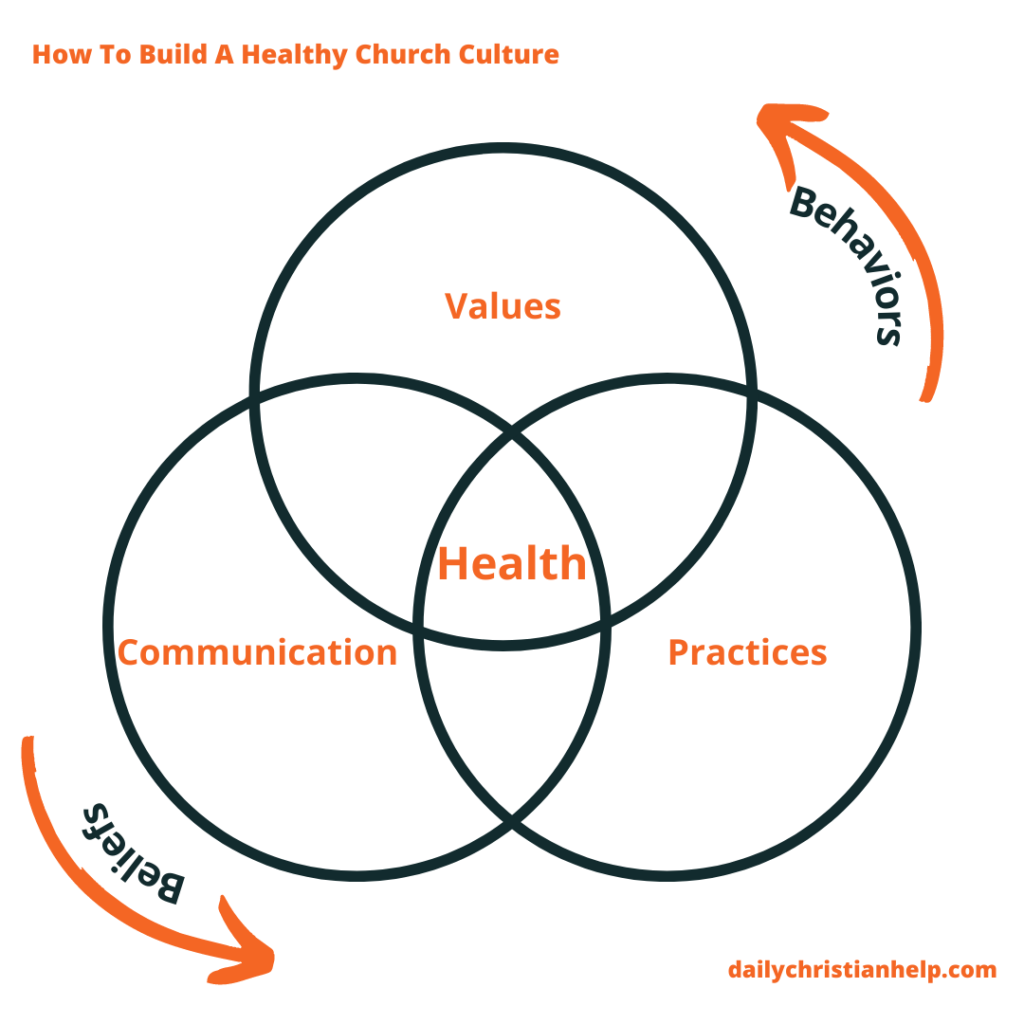Healthy church culture is a vital aspect of being effective, both internally as a team and with those you are shepherding. While there will always be problems, it is possible to create a church culture so that staff, volunteers, and congregation members can flourish.
Every church, organization, family, etc., has a culture. Whenever there is a gathering of individuals around shared goals or ideas, there are beliefs, attitudes, and practices that shape the culture of those people.
As people assemble around common beliefs representing your church, they witness the words and actions that drive change, good or bad. Therefore, leaders must have a keen awareness of how the behaviors that exist within the church are shaping the culture.
The attitudes and behaviors within a team are the most significant influence on the culture of a church.
Creating a healthy church culture requires leaders to pay careful attention to how behaviors affect outcomes within the organization.
If your church is struggling with toxicity or you want to ensure you avoid it, keep reading to discover the necessary components for creating a healthy culture for people to thrive.

What is Church Culture?
Church culture is the environment and atmosphere distinct to a community that results from consistent beliefs and behaviors. The values, communication, and practices within a church exhibit behaviors representing the underpinning beliefs held by those who can influence the culture.
In other words, what leaders actually believe is accurately revealed by the behaviors.
Culture can be defined as the ways people in the organization behave and the attitudes and beliefs that inform those behaviors. – hbr.org
There are no perfect churches, but consistent behavior patterns are a better indicator of deep-seated beliefs than a mission statement or list of core values.
The culture of your church can either help people thrive or cause it to become toxic. If it becomes toxic, it is because leaders put little to no care or effort into changing beliefs that influence behaviors that ultimately hurt the organization.
How To Create A Healthy Church Culture That People Thrive In
People create the culture of your church. To intentionally form and maintain a healthy culture, instead of letting it accidentally develop, you must give sincere attention to the three cultural components. To create a healthy church culture, leaders must prioritize effort in three critical areas: essential values, open communication, and habitual practices.
Before moving on, it is necessary to nuance the relationship between beliefs and behaviors. If you or your team members lack self-awareness, you can miss the direct impact pride, fear, or other personal insecurities have on behavior. For example:
- You may believe that it is important to empower others while also believing that others will not perform the same task as highly as you.
- You can know a helpful critique of your work can make it better but become defensive because you believe they want to hurt more than help.
- You may inherently believe that people are valuable, yet believe that you can disregard their opinion or perspective if it is different from yours.
- You may believe that resolving conflict is best, but also believe that it can go away if you avoid it.
- You can want the best for the team but allow it to suffer by believing that the adverse effects of a bad apple are minor or non-existent.
There is a strong tension between honorable beliefs and those muddied by insecurity.
It is often easier to lean into beliefs that protect us rather than cause us to become vulnerable. However, beliefs that abandon insecurities are the most effective at driving behaviors that create a healthy culture.
To build a strong culture in your church, you must identify, model, and support the beliefs that lead to healthy behaviors in each area. Below are the three areas that can support a healthy church culture and examples of beliefs and behaviors that can help each aspect. You can expound upon or add more, but the three cultural components must remain intact.

The 3 Necessary Components To Build A Healthy Church Culture

1. Essential Values
Building a healthy church culture requires identifying and adhering to values of service, trust, and collaboration. If you or your team do not have values representing how you interact and empower one another, the culture will never be healthy.
Too often, core values only reflect how the church performs and overlook how they will guide the team toward health and support. Creating excellent services, programs, and outreaches with a toxic, unhealthy culture is possible.
The culture of your church will not be healthy if your values only emphasize outcomes from people and not an orientation toward people.
Your values must intentionally drive people toward service, trust, and collaboration. Values that reinforce a healthy culture are driven by beliefs and behaviors that emphasize supporting one another. There are critical beliefs that inspire healthy behaviors of service trust and collaboration.
Service Is An Essential Value.
- Belief: We’re called to serve others.
- Behavior: Seek to understand the need.
Valuing service is fundamental to fulfilling the purpose of the church. It is necessary to define behavior related to this belief because it is easy to overlook the micro-level of service to one another by focusing on the macro-view of servicing a community.
Trust Is An Essential Value.
- Belief: Growth requires trust.
- Behavior: Identify competency and share responsibility.
Trust sits at the foundation of every healthy relationship. Creating an environment of trust will empower your team and accelerate progress.
When high trust exists, it eliminates stress and empowers others to excel, make decisions, and feel secure in their role.
Collaboration Is An Essential Value.
- Belief: Collaboration builds relationships.
- Behavior: Invite the expertise of others.
True collaboration goes beyond asking others for opinions; it involves evolving ideas from the original thought to something better by melding with others’ expertise, knowledge, and insight.
Of course, there are additional values you could add to this list; however, these three are essential and trademarks of healthy environments. Church leaders who choose to believe and behave according to these values will make significant strides toward a thriving culture.

2. Open Communication
Excellent communication is a vital component of healthy church environments. Communication that strengthens a secure culture focuses on purpose, transparency, and clarity. If people do not understand why something matters, feel confused, or have unclear expectations, the culture of your church will be built around their assumptions.
Using communication in your church can foster growth or harm its potential. Communication can help build credibility and cut down gossip or raise questions and cause people to feel unsettled.
If you want to strengthen the culture of your church, communication must explain why more than what, offer transparency, and provide clarity.
Communication that reinforces a healthy culture is driven by beliefs and behaviors prioritizing truth above reputation.
Explaining Why Causes Open Communication
- Belief: People support what they believe.
- Behavior: Focus on why more than what.
Pastoring, volunteering, or attending church can feel more like obligations than a calling when leaders do not articulate why a cause, idea, or even scripture is relevant.
A clear sense of WHY gives people a way to tell the outside world who they are and what they believe. – Simon Sinek
If people cannot connect the dots between tasks or responsibilities to meaning and purpose, they will drift toward disconnection.
Transparency Causes Open Communication
- Belief: Transparency eliminates confusion.
- Behavior: Prioritize respectful honesty above everything else.
Honest communication will build equity, in some cases, even when being upfront is not advantageous to the church.
Transparency is the practice of being open and honest with others, no matter how challenging it might be. For both personal and professional relationships to thrive, you need to eliminate the stigma that comes with being straightforward. – fellow.app
Transparent communication requires sharing the good and bad details with those whom the information directly impacts.
Clarity Causes Open Communication
- Belief: Clarity reduces stress.
- Behavior: Define expectations and provide context.
Clear communication prevents misunderstandings and ambiguity. It also helps people assume ownership and take action.
Clarity ensures that your team members’ work is aligned with your goals and mission. Your team will know that what they are doing matters. – Craig Groeschel
If team members or your congregation are guessing about what you mean or what is expected from them, it will elevate stress: people will grow tired of guessing and either burnout or jump ship.

3. Habitual Practices
There are necessary practices that need to be habitual responses to create a healthy environment. Holding space for asking questions, addressing problems, and sharing feedback will communicate to your team that a healthy culture matters.
Leadership requires a willingness to navigate difficult conversations and situations. It also requires humility to listen and, in some cases, to make changes, personally and organizationally.
Leaders who build great cultures practice emphatic listening, address problems, and encourage feedback. These are not easy habits and require a commitment to practicing them to keep the culture from drifting toward indifference, passivity, and personal preferences.
Practice Listening
- Belief: Listening first increases empathy.
- Behavior: Ask questions before drawing conclusions.
Asking questions is a vulnerable action. It conveys that you do not have all of the answers nor understand all aspects of the organization.
Leaders who ask powerful questions have the greatest success in seizing new opportunities and addressing unexpected challenges — and they build cultures that will carry these benefits into the future. – hbr.org
Asking questions and carefully listening can help leaders better understand the church’s strengths and weaknesses.
Practice Resolving Conflicts
- Belief: Resolving conflict prevents drama.
- Behavior: Address problems quickly.
Resolving conflict quickly does two things: it communicates that you will address problems and care about the team’s overall well-being of the group. Ignoring problems is a surefire way to allow toxicity to spread throughout your church.
Unresolved conflict is often at the root of many people who experience hurt in the church. Weaving conflict management, grace, correction, and forgiveness into the fabric of your church culture will normalize addressing problems quickly and help prevent more church leadership problems.
Practice Exercising Feedback
- Belief: My preferences can blind awareness.
- Behavior: Give and receive feedback regularly.
Constructive feedback reinforces positive behavior and can correct negativity, attitudes, or actions contrary to healthy church culture. Your team must be receptive to feedback, and the best way to help instill it within your church is by welcoming it first.
Closed-mindedness toward feedback could indicate one or two things (or both): a lack of trust or a lack of security. – catalystleader.com
If you or team members are not receptive to feedback, it will increase frustration, create ministry silos, and prevent a thriving environment.
Church staff and volunteers thrive when the beliefs and behaviors associated with the people-oriented values, open communication, and habitual practices support a healthy culture.
Understanding what a healthy environment requires is the best way to begin molding or reshaping the culture of a church. All culture is a result of the beliefs and behaviors of people.
Leaders in the church can form better relational dynamics by modeling healthy beliefs and behaviors to support the three cultural components: Values, Communication, & Practices. Healthy beliefs and behaviors in these three areas will result in healthy church culture.
5 Steps To Create Or Shift The Culture Of Your Church
- Apply The 3 Necessary Components Of A Healthy Church Culture Outlined In This Article
- Model The Culture You Want To Experience
- Rally Your Team Around Beliefs & Behaviors That Support Health
- Identify & Toxic Traits & People Unwilling To Change
- Celebrate Beliefs & Behaviors That Strengthen The Culture
Do You Need Help Shifting Your Church Culture?
Sometimes it is helpful to have outside perspective and influence to help address church culture issues your team is facing. There are two workshops that I recommend for churches to experience that want to increase the health of their culture. To learn more about both opportunities, check out the post: 3 Church Leadership Workshops For Transformation & Growth.
Both workshops offer virtual or live opportunities. These workshops can help teams optimize church culture by exploring how to increase trust, make better decisions, increase collaboration, and resolve conflict.
Church Culture Summary
Creating a positive church culture begins with understanding the characteristics that make one work in the first place. All church culture is built on beliefs and behaviors, whether good or bad, that influence the environment.
To build a healthy church culture, you must identify and model empowering beliefs and behaviors in three necessary components: essential values, open communication, and habitual practices.
Church culture is complex, but it is possible to create an environment that people thrive in and support. Review the steps above or check out the workshops available to you to get started.





